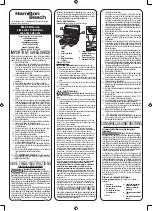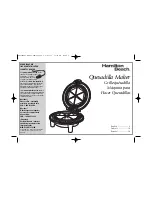
Processing of honey
27
priming problems are solved as follows:
Leaks
In the case of priming problems, honey can also be sealed at the
following parts (see
Fig. 27
):
- gasket for clamping flange (
1
)
- connection between pipe bend and hose (
2
)
- connection between check valve and hose (
3
)
- filling nozzle.
Very slightly viscous honey runs back and at the same time air
enters the filling nozzle
- use the check valve
- fill slightly viscous honey as cool as possible (approx. 15-20 °C)
- increase storage tank. If the honey drips out of the filling nozzle,
the storage tank has to be lowered for preasure reduction.
priming problems with highly viscous honey
Convert the check valve to an intake cage by removing the flange
and the membrane. The wing screws are reassembled as priming
protection (see
3
,
Fig. 27
). Keep the hose as short as possible.
Attention:
In the case of very slightly viscous honey the filling nozzle
will begin to drip if the filling level in the storage tank is higher than
the filling nozzle. Then the storage tank must be correspondingly
lowered.
Alternatively the flat filling nozzle can also be inserted in the pump
head instead of the gasket for clamping flange (see
Fig. 30
).
8.2
Preparation of the honey for the filling
- Filter wax from honey in a cleaning basin
- honey must be in liquid form
- honey must be freshly stirred, in order to prevent possible temperature
differences (density variations) in the container.
Processing temperatures of the honey
- slightly viscous honey freshly extracted: 20-25 °C/ 68-77 °F
- creamed honey with low water content (approx. < 16 %): 26-35 °C/ 79-95 °F
- maximum temperature: 40 °C/ 104 °F
Using the machine at higher temperatures can clog the gears due to an expansion in
the pump head.
Density variations cause filling inaccuracies.
If the honey gets colder during the bottling/pumping, the
machine could be damaged - for that we assume no liability!
















































